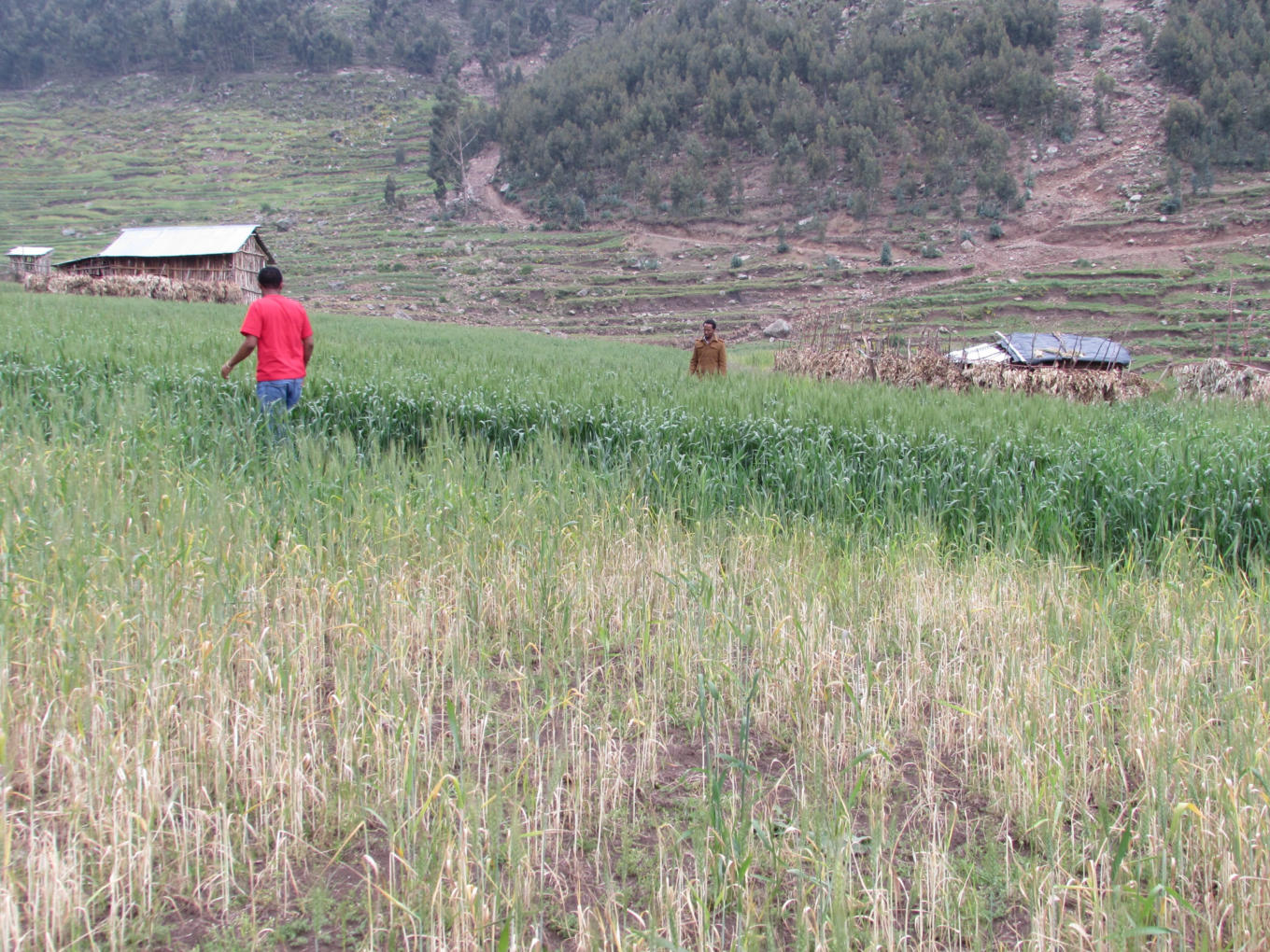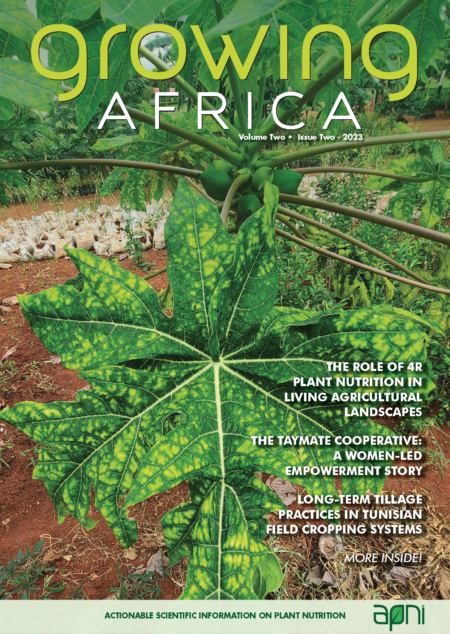By Tilahun Amede and Asseta Diallo
Smallholder farmers have faced a myriad of constraints that collectively act to limit the effectiveness of scarce fertilizer inputs. Case study examples provided from the Ethiopian Highlands provide a means to discuss key interventions that can help raise nutrient use efficiency across fields with varying responsiveness to fertilizer application.
While global fertilizer use has significantly increased since the 1960, and played an important role in the Green Revolution in South America and Asia, fertilizer use in Africa has remained very low, near 18 kg nutrients ha-1. Increased use of fertilizers, improved seed, and irrigation in Asia and Latin America have combined to increase cereal yields from 1.3 t ha-1 in the 1960s to above 4.0 t ha-1 in 2009 (Van der Velde et al., 2013). During the same time, average cereal yields in sub-Saharan Africa (SSA) have stagnated near 1.5 t ha-1 while the yield gap, attributed mainly to low and inefficient use of agricultural inputs, remains very high.
While smallholder farmers in SSA appreciate the benefits of fertilizers, and African governments have increasingly invested in fertilizer purchases since the 2006 Abuja declaration, access to fertilizer remains severely restricted. Bationo et al. (2004) found that farmers in SSA removed about 4.4, 0.5, and 3.0 million (M) t ha-1 yr-1 of nitrogen (N), phosphorus (P), and potassium (K); while only returning 0.8, 0.3, and 0.2 M t, respectively, and little has changed since then. Hence, soil nutrient mining amounts to five times nutrient application every year. Many factors constrain the use of fertilizer by smallholder farmers and this situation is especially aggravated by the following issues:
1. Access to inputs: Smallholder farmers have limited financial resources and market access to appropriate chemical fertilizers. Fertilizer prices are impacted by long value chains and unregulated markets, particularly in landlocked countries, where prices could double over short distances. Past samples of average prices for urea found them lowest in Ghana (0.80 USD kg-1), Kenya (0.97 USD kg-1), and Nigeria (0.99 USD kg-1), while fertilizers are most expensive in landlocked countries (Burundi: 1.51, Uganda: 1.49, and Burkina Faso: 1.49 USD kg-1; Bonilla Cedrez et al., 2020). Unless strategic and targeted use of fertilizers is employed, the economic returns to investment in fertilizer by smallholder farmers is very poor under the prevailing production and market conditions. The most recent increases in fertilizer prices are already impacting the costs of both inputs and food imports in SSA.
2. Low agronomic fertilizer use efficiency: Crop responses to fertilizer are on average low, but tend to be highly variable at various spatial scales in SSA (Kihara et al., 2016; Vanlauwe et al., 2011). This is caused by soil chemical constraints (e.g., soil acidity), soil physical constraints (e.g., soil crusting), drought, pests and diseases, and a lack of high yielding varieties (Vanlauwe et al., 2011; Zingore et al., 2015). The options for circumventing these yield-limiting factors through cropland expansion, to feed Africa’s growing population, are increasingly limited. Moreover, crop response to fertilizer can be highly variable across short distances (Fig. 1). The types and amounts of nutrient required are commonly dictated by soil type, landscape position, seasonal climate, and on-farm management (Amede et al., 2020). Improving agronomic practices and targeting of fertilizer inputs within farms and landscapes can improve nutrient use efficiency (NUE) without reducing productivity (Fixen et al., 2014).
In the context of SSA, there are three typical categories of crop response to fertilizer application, which are depicted in Fig. 1 and Box 1.

Box 1
Type I: Where crop response to fertilizer application is high
Farm 1 is located in Endamohoni, Northern Ethiopia, an area receiving > 700 mm of rainfall (Figure 1a). Fields are in footslope positions and soils are slightly acidic. The wheat crop was most responsive to N application (85% of the yield increase), followed by P. Wheat yields can be remarkably high (up to 8 t ha-1) on the deep, N-limited soils that are commonly situated close to homesteads. These flat-land soils also have loamy textures, neutral pH, and high soil water holding capacity (Amede et al., 2020; Desta et al., 2022). The proportion of farmland with these responsive traits vary from 25–60%, depending on the geomorphology, climate, and slope forms. These farms usually receive preferential treatment by farmers, including compost and manure application, addition of crop residue and timely weeding. These are also areas where the growing season is long enough to support high yielding varieties, which allows for extended uptake of nutrients by crops.
Type II: Where crop response to fertilizer application is moderate
Farm 2 is located in high annual rainfall (1,080 mm) area of Lemo, Ethiopia (Figure 1b). These soils are relatively flat and deep Nitisols, which are acidic and prone to P-fixation and excessive leaching. Wheat is most responsive to N and P, although about 33% of the yield gains can be attributed to potassium (K) fertilizer. These are relatively well managed farms usually situated in midslopes, where farmers regularly apply fertilizers (mainly DAP and urea). Grain legumes are commonly included within crop rotations.
Type III: Where crop response to fertilizer is very low or non-responsive
Farm 3 (Figure 1c) is located less than a kilometre away from Farm 1. This farm is situated in the hillslopes, where erosion is severe, soils are shallow, and soil organic matter (SOM) is low. Farmers rarely apply manure as they receive very limited return for their investment. These fields are commonly characterised as “outfields” with low pH, shallow soils with sandy surface textures and subsurface hardpans. The site rarely responds to fertilizer NPKS application, regardless of the rate or time of application.
Interventions to increase agronomic fertilizer use efficiency and crop yield
Our observations from the fields of the Ethiopian Highland region lead us to suggest the following major intervention areas to improve crop response to application of external inputs in non-responsive soils.
1. Appreciate the influence of soil and landscape diversity
Crop response to fertilizer application typically varies within very short distances (Fig. 1), and this is mainly associated with changes in geomorphology, soil types and landscape positions, and farm management. Fertile soil, with adequate and balanced nutrients, could be considered as productive soil if the climatic and management conditions are favorable for crop growth.
Not all soils in SSA with low nutrient content respond to fertilizer applications. In a cross-continental study on maize response to NPK fertilizers, Kihara et al. (2016) reported that maize was highly responsive in only 11% of the fields, ‘intermediately responsive’ in 36% of fields, and ‘non-responsive’ in 53% of fields. Similarly, the application of mineral fertilizers failed to increase maize yields by more than 0.5 t ha−1 in up to 68% of farmer fields (Roobroeck et al., 2021). Moreover, Roobroeck et al. (2021) showed that 15% of maize fields in Kenya, 34% in DR Congo, 14% in Tanzania, and 55% in Nigeria were non-responsive to fertilizer applications. Low maize response was recorded mainly in nutrient poor, acidic and degraded soils, similar to the observations from wheat systems (Amede et al., 2020). Roobroeck et al. (2021) found neutral pH and low aluminum (Al) concentrations to be associated with a cluster of highly responsive sites across countries. This calls for land suitability indicator tools for major cereal crops.
Landscape position is another major factor dictating crop response in the East African highlands, where geomorphological variability is high (Amede et al., 2020). Farming systems and landscape positions are highly variable and hence nutrient mobility in the soil and their effect on plant uptake are also likely to vary. Desta et al. (2022) found crop yields to be strongly and significantly affected by landscape positions across agro-ecologies and farming systems (Fig. 2). Sorghum response to fertilizer application was 50–300% higher in footslopes compared to hillslopes, depending on locations and inputs levels. The high NUE in valley bottoms compared to hillslopes was explained by higher soil water holding capacity, higher adsorption and desorption capacity of cations, higher SOM content, and deeper topsoils. Due to its close relationships with other covariants such as SOM and soil depth, landscape position could serve as an important proxy soil fertility for smallholder farmers and extension agents.
2. Rejuvenate soils with cover crops and liming
High NUE requires good agronomic management of soil water and crop nutrients (Fixen et al., 2014). Soil water status is strongly linked to SOM content, which at 0.5–1.5% is very low in SSA. The differential treatment of fields within the farms highlighted in Fig. 1 created a clear soil fertility gradient over years, with SOM in the outfields being up to 40% lower than homestead fields in the study area. Low SOM affects crop responses to nutrient application through reduced soil water holding capacity, soil biology, and retention of nutrients (Zingore et al. 2015; Vanlauwe, et al., 2011). As an example, fertilizer application following fast growing cover crops like vetch contributed to the SOM pool, soil water content, and improved wheat grain yields by 40% compared to use of fertilizers alone (Amede et al., 2021).
Soil acidity has been a major problem that affects nutrient availability in Acrisols, Nitisols and Leptosols that dominate the high rainfall Ethiopian highlands. Crop yields are consistently low in these low pH soils regardless of amount of nutrients added, primarily due to P-fixation and Al-toxicity. Adequate liming substantially increased maize and wheat yields by about 70%, compared to recommended NPK fertilizer rates alone (Agegnehu et al., 2021), while cover crops increased soil pH by a unit of 0.5 (Amede et al., 2021). In fact, the yield impact was higher in non-responsive soils in hillsides and low pH soils. Application of lime in acidic soils along with improving SOM contributes to enhanced NUE of cereal crops in global crop production systems (Fixen et al., 2014).
3. Increase plant population for enhanced resource use efficiency
The benefit of good agronomy in enhancing agronomic efficiency has been highlighted earlier (Vanlawe et al., 2011; Fixen et al., 2014), contributing to lower costs and improved efficiency by concentrating applied nutrients in the root zone.
One major driver of yield loss in SSA is low plant density in farmers’ fields. While low plant density has been practiced in low or no input systems of SSA, this same population cannot support optimal yields with increased use of fertilizers and improved varieties. Modern hybrids are able to withstand greater stress attributable to high population densities than older hybrids, which in turn enables producers to establish higher plant populations, leading to higher yields per unit area (Duvick, 1997). In small scale farming of SSA, low plant population of cereals (commonly < 18,000 maize plants ha-1) is found to be a major constraint affecting crop yield and NUE. For instance, Amede (1995) found that the maize population in smallholder farmers’ fields is about 46% lower than the commonly recommended plant density. Maize grown in dry environments yielded better with higher plant population near 65,000 plants ha-1 (Amede, 1993); while in humid areas with optimum fertilization, maize yield increased with populations up to 100,000 plant ha-1 (Haarhoff and Swanepoel, 2018).
Increased use of N fertilizer should be accompanied by increased plant density to maximize NUE and reduce N losses (Haarhoff and Swanepoel, 2018). Similarly, Zhao et al (2019) argued that farmers’ limited knowledge of appropiate plant population density and density loss is an urgent problem that needs to be solved in maize production as about 60% of farmers were failing to account for these factors over the growing season. Amaral et al. (2020) showed that maize yield in Mozambique in 2017 was less than half (0.8 t ha-1) of that observed in Malawi (2.0 t ha-1) and almost a third of the yield in Zambia (2.5 t ha-1), and this was mainly attributed to very low planting density of < 20,000 plants ha-1. There has been also a recommendation for smallholder maize farmers in Kenya to initially target 60,000 maize plants (CropNuts, 2022) even though the recommended plant population in the extension system, developed by KALRO, is only between 37,300 and 52,700 plants ha-1 (Esilaba et al., 2021).
Summary
Crop yields in SSA are mainly constrained by nutrient deficiency. Recent hikes in fertilizer costs will exacerbate this problem. In the absence of soil testing and crop response-based fertilizer recommendations, smallholder farmers achieve low agronomic and economic returns by applying low rates of fertilizers across all their fields. Existing fertilizer recommendations fail to account for both farming system diversity and the impact of a field’s location within the landscape. Landscape position dictates crop yield responses due to the effects of slope, water holding capacity, and inherent soil fertility. In addition, higher plant population, use of N-fixing cover crops and good agronomy (including weed control) would help farmers use fertilizer more efficiently. In more than 1,000 field trials with wheat and sorghum, at least 80% of yields stemmed from applying N and P fertilizer, with the highest benefit obtained in the valley bottoms and flat lands. n
Dr. Amede (e-mail: tamede@agra.org) and Dr. Dialo are with the Alliance for Green Revolution in Africa (AGRA), Nairobi, Kenya.
Cite this article
Amede, T., Dialo, A. 2022. Enhancing Agronomic Efficiency of Fertilizers in Sub-Saharan Africa: Evidence from the Field. Growin Africa 1(1), 18-22. https://doi.org/10.55693/ga11.hhwj4044
References
Agegnehu, G., et al. 2021. Extent and management of acid soils for sustainable crop production system in the tropical agroecosystems: a review, Acta Agric. Scandinavica, Section B — Soil & Plant Science 71(9), 852-869.
Amede T., et al. 2020. Landscape positions dictating crop fertilizer responses in wheat-based farming systems of East African Highlands. Renewable Agric. Food Syst. 1-13.
Amede, T., 1995. Yield gain and risk minimisation in Maize through cultivar mixtures in the southern rift valley, Ethiopia. Exp. Agric. 31, 161-168.
Bationo, A., et al. 2004. The African Network for Soil Biology and Fertility: New Challenges and Opportunities. In: Bationo, A. (ed.). Managing nutrient cycles to sustain soil fertility in Sub-Saharan Africa. pp. 1-25. Academic Science Publishers, Nairobi, Kenya.
Bonilla Cedrez, C., et al. 2020. Spatial variation in fertilizer prices in Sub-Saharan Africa. PLoS ONE 15(1), e0227764.
CropNuts. 2022. Maize Plant Populations. https://cropnuts.com/maize-plant-population-seed-rate. Acessed on 29.03.2022.
Desta, G., et al. 2022. Sorghum yield response to NPKS and NPZn nutrients along sorghum-growing landscapes. Exp. Agric. 1-16.
Duvick, D.N. 1997. What is yield? In: Edmeades, G.O., et al. (eds.). Developing drought- and low N-tolerant maize: Proceedings of a symposium, El Batán, Mexico. 25-29 Mar. 1996. CIMMYT, Mexico City. pp. 332-335.
Esilaba, A.O. et al. 2021. KCEP-CRAL Maize Extension Manual. Kenya Agricultural and Livestock Research Organization, Nairobi, Kenya.
Fixen, P., et al. 2014. Nutrient/Fertilizer Use Efficiency: Measurement, Current Situation and Trends. In: Managing Water and Fertilizer for Sustainable Agricultural Intensification. ISBN 979-10-92366-02-0IFA, IWMI, IPNI and IPI, April 2014.
Haarhoff, J.S. and Swanepoel, P.A. 2018. Plant population and maize grain yield: A global systemic review of rainfed trails. Crop Sci. 58, 1819-1829.
Kihara, J., et al. 2016. Understanding variability in crop response to fertilizer and amendments in sub-Saharan Africa. Agric. Ecosyst. Environ. 229, 1-12.
Roobroeck, D., et al. 2021. Assessing and understanding non-responsiveness of maize and soybean to fertilizer applications in African smallholder farms. Agric. Ecosyst. Environ. 305, 107165.
van der Velde, M., et al. 2013. Affordable Nutrient Solutions for Improved Food Security as Evidenced by Crop Trials. PLoS ONE 8(4), e60075.
Vanlauwe, B., et al. 2011. Agronomic use efficiency of N fertilizer in maize-based systems in sub-Saharan Africa within the context of integrated soil fertility management. Plant Soil 339, 35-50.
Zhao, Y-J., et al. 2019. Causes of maize density loss in farmers’ fields in Northeast China. J. Integr. Agric. 18(8), 1680-1689
Zingore, S., et al. 2015. Soil degradation in sub-Saharan Africa and crop production options for soil rehabilitation. Better Crops. 99, 24-26.





